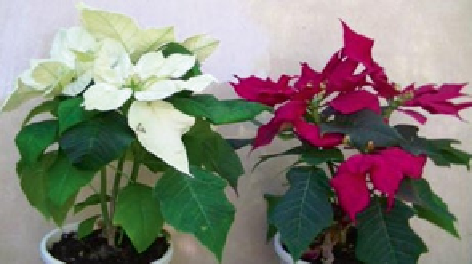Agriculture Reference
In-Depth Information
Fig. 12.6
Potted poinsettia
with cream and red flowered
bracts. (Photo courtesy of K.
Seaton, Department of Agri-
culture and Food, Western
Australia)
poinsettia (
Euphorbia pulcherrima
) pot plant offers new colour forms (Fig.
12.6
)
(Ecke et al.
2004
).
In 1985 the United Kingdom introduced HAPIE or the Hardy Amenity Plant
Introduction and Evaluation scheme. This was based on the realisation that there
were a large number of plants in existing botanic gardens that were unused or not
realised by the nursery and garden industry. Through agreement between nurs-
erymen, scientists and the Royal Botanic Garden, Edinburgh, the HAPIE Plants
were developed to trial and develop methods to propagate, grow and evaluate
these plants to introduce the most suitable of these plants into the nursery and
garden trade (Dixon
1989
). The Canadian scheme: University of British Colum-
bia Plant introduction Scheme of the Botanical Garden (PISGB) was run by the
late Bruce MacDonald at Vancouver Botanical Gardens and was very success-
ful at bringing new plants to the garden, trialling, propagating and distributing
them to local nurseries. These were sourced from plant enthusiasts and working
with overseas collections and collectors. These plants included
Arctostaphylos
uva-ursi
'Vancouver Jade' and
Genista pilosa
'Vancouver Gold' collected from
Vancouver Island by E.H. Lohbrunner, and
Penstemon fruticosus
'Purple Haze',
a wild collection by Al Rose from British Columbia. New forms of orange flow-
ered honey suckle (
Lonicera
spp.) 'Mandarin' hybridised by Wilf Nicholls, the
Clematis chiisanensis
'Lemon Bells' from Korean seed 'Blue Ravine' were tested
and promoted (Justice
2002
).
Customer requirements
One of the most difficult questions is working out what
the customer wants in purchasing ornamental plants. This can often be gauged by
introducing new plants to trade fairs and demonstrating the range and uses of a
plant. Working groups are an effective way of achieving a consensus of new plants
to introduce into the market. In 1981 Germany involved the cooperation of a large
group of people including growers, botanical garden personnel, researchers and oth-
ers concerned with plant development in the establishment of their working group
(WG) New Ornamental Plants in seeking consensus of new plant material (von
Hentig
1995
). These working groups now exist in most of the developed world,
where the exchange of information occurs on the performance of a large number of
plants tested from numerous overseas collections. The participants regularly met to

